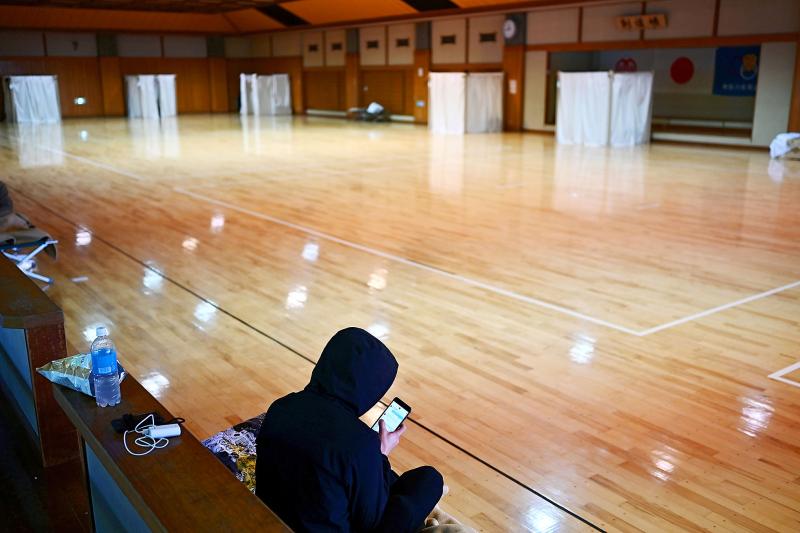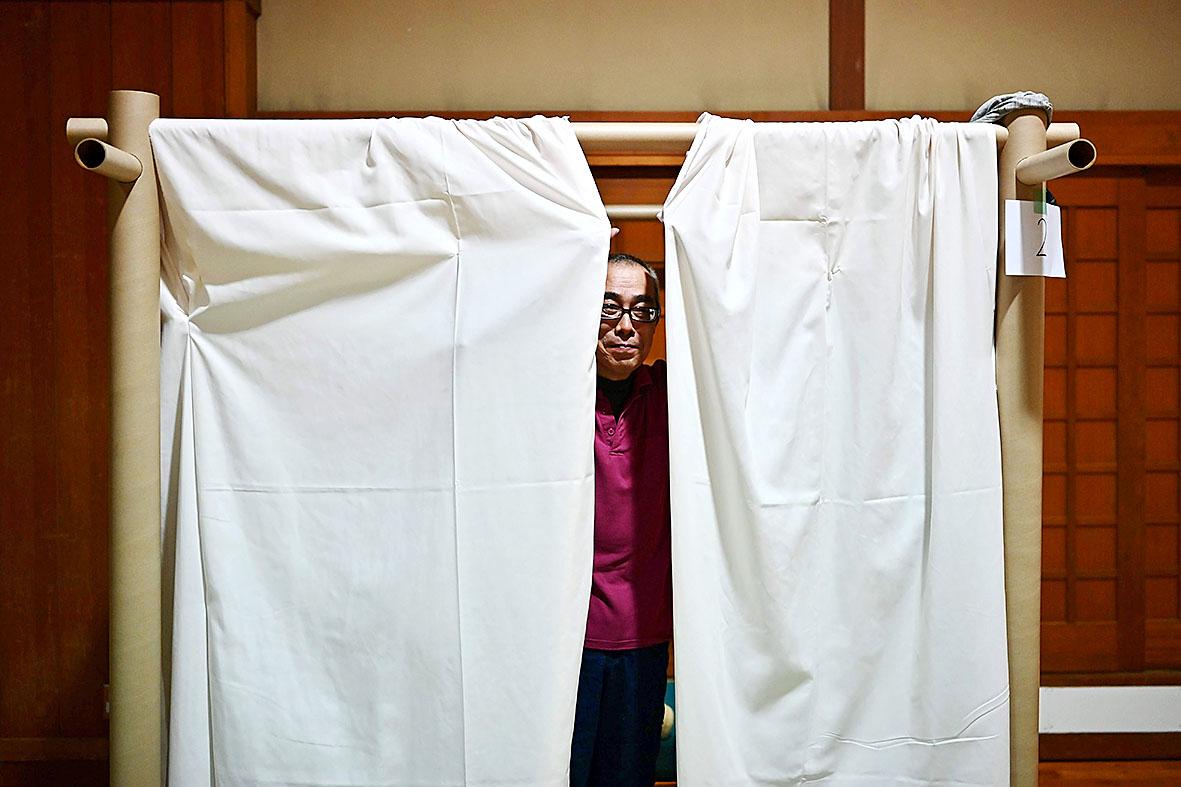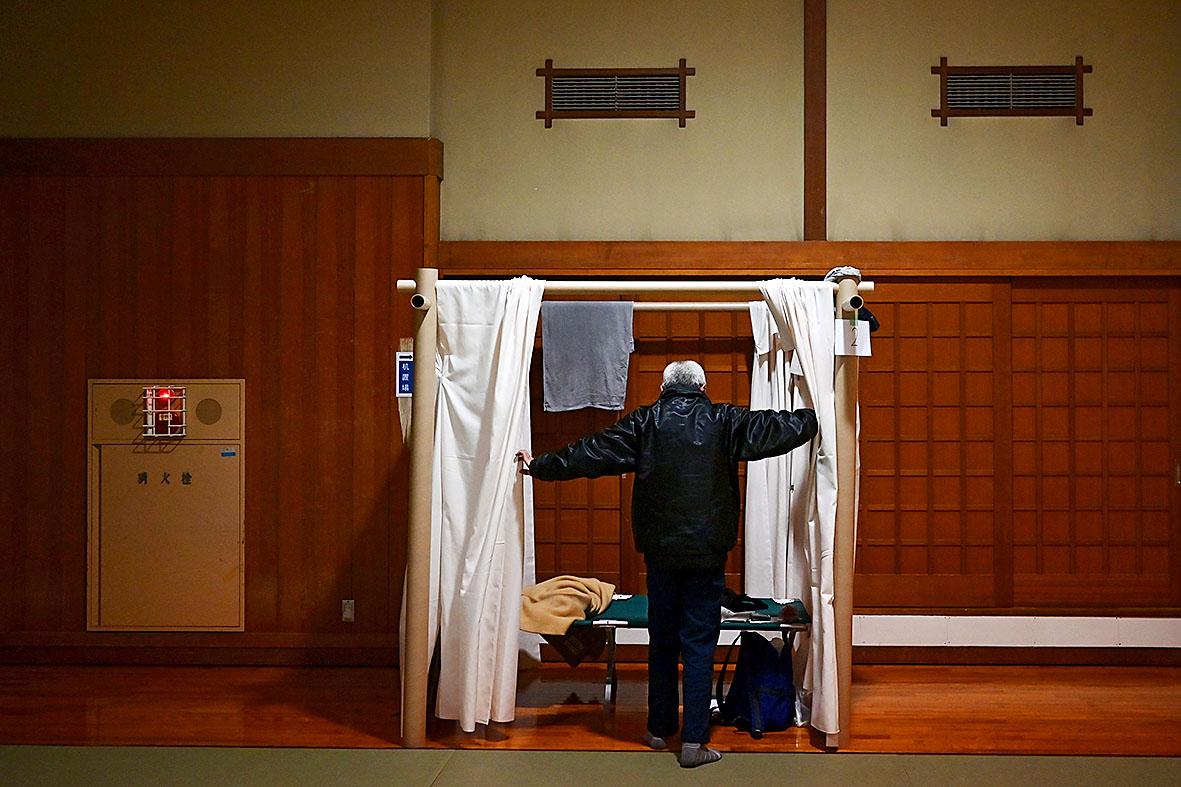Thousands of homeless “net cafe refugees” in Japan risk being turfed out onto the streets as the coronavirus pandemic forces the sudden closure of their uniquely Japanese 24/7 comic book havens.
The ubiquitous all-night internet and “manga” comic cafes offer couches, computers, comics, soft drinks and shower facilities for an overnight stay typically priced around 2,000 yen (US$18).
An estimated 4,000 people down on their luck make their home in such cafes in Tokyo alone, and activists worry that shutting them down could lead to suicides and a spike in rough sleepers.

Photo: AFP
Some local authorities are now opening shelters to accommodate “net cafe refugees” and keep them from sleeping out in the open.
One 58-year-old occasional construction-site worker said his main aim was “avoiding getting wet,” as he found a roof over his head at a shelter converted from a martial arts center in Yokohama near Tokyo.
“I thought of sleeping on a bench at a train station... or subway stairs going underground,” said the grey-haired man, who declined to give his name.

Photo: AFP
His net cafe informed him at the weekend it would be closing due to state of emergency measures in Japan to stem the spread of the coronavirus.
“I used to go to work from net cafes... now I sometimes have a job, sometimes not, due to the coronavirus,” he said, adding that it was nearly impossible to find a permanent job at his age.
Renting an apartment in Japan requires a very expensive deposit and presents tricky administrative hurdles, leaving net cafes a convenient option for many of the country’s hidden poor.

Photo: AFP
“I have nowhere to go to, few acquaintances,” said the man.
‘DISCREET AND QUIET’
The temporary shelters at the judo hall in Yokohama, operated by the local Kanagawa authorities, have been designed by a team led by award-winning Japanese architect Shigeru Ban to offer privacy and prevent infections.
Residents sleep on camp-style cots or cardboard beds partitioned off by a frame of sturdy paper tubes with cloth hanging from the top of the cubicle to the floor.
Ban is famed for other emergency shelters and buildings, including the Cardboard Cathedral for Christchurch in New Zealand after the 2011 earthquake.
The aim is to provide a safe place to those driven out by the coronavirus crisis, said Yuji Miyakoshi, an official at the municipal government.
The free shelter has hosted nearly 40 people since opening on Saturday and one resident said it had been proved invaluable after his “capsule hotel” accommodation closed two days ago.
“I went to work, slept at the hotel and went back to work. I moved to this place but nothing has changed so much,” said the man in his 30s who works in construction.
Miyakoshi said the people in the shelter were “quite discreet and quiet... My feeling is that many of them are obviously not good at asserting themselves.”
‘UNSAFE HOUSING CONDITIONS’
On the surface, Japan appears a wealthy and prosperous society and visitors to Tokyo and other major cities are often struck by the relative lack of homeless people seen in other world capitals.
The Japanese economy bounced back from a recession in the 1990s, creating millions of new jobs, but critics said many of them were temporary and created a new class of urban poverty.
The manga cafes were initially a haven for late-working — or late-drinking — business people from far-flung suburbs who missed the last train home, but eventually became a shelter for Japan’s working poor.
Coronavirus has driven these people into a corner, said Tsuyoshi Inaba, who has long been involved in helping homeless people.
Inaba estimates there are already 2,000 homeless in Tokyo — double the official figure — as public surveys conducted during the day often miss people sleeping rough at night after a day’s work.
Combined with 4,000 net cafe refugees, “some 6,000 people are in unstable, unsafe housing situations” in Tokyo alone, Inaba said.
The Tokyo Metropolitan Government, which ordered establishments such as net cafes closed amid a spike of coronavirus cases in the capital, is trying to find a solution for the hundreds abruptly made homeless.
But activists say not enough accommodation is being provided and that the conditions are too onerous — such as requiring applicants to prove they have been in Tokyo for six months or longer.
Many kicked out of net cafes have no option but to sleep on the street if they can’t find a proper shelter, Inaba said, adding: “This could cause social confusion and suicides are feared to increase.”
If official aid remains inadequate, Inaba foresees a “big problem” that could even contribute to a further spreading of coronavirus.
“Some people could move to provincial cities despite the possibility that they may have the virus,” he warned.

April 14 to April 20 In March 1947, Sising Katadrepan urged the government to drop the “high mountain people” (高山族) designation for Indigenous Taiwanese and refer to them as “Taiwan people” (台灣族). He considered the term derogatory, arguing that it made them sound like animals. The Taiwan Provincial Government agreed to stop using the term, stating that Indigenous Taiwanese suffered all sorts of discrimination and oppression under the Japanese and were forced to live in the mountains as outsiders to society. Now, under the new regime, they would be seen as equals, thus they should be henceforth

Last week, the the National Immigration Agency (NIA) told the legislature that more than 10,000 naturalized Taiwanese citizens from the People’s Republic of China (PRC) risked having their citizenship revoked if they failed to provide proof that they had renounced their Chinese household registration within the next three months. Renunciation is required under the Act Governing Relations Between the People of the Taiwan Area and the Mainland Area (臺灣地區與大陸地區人民關係條例), as amended in 2004, though it was only a legal requirement after 2000. Prior to that, it had been only an administrative requirement since the Nationality Act (國籍法) was established in

With over 80 works on display, this is Louise Bourgeois’ first solo show in Taiwan. Visitors are invited to traverse her world of love and hate, vengeance and acceptance, trauma and reconciliation. Dominating the entrance, the nine-foot-tall Crouching Spider (2003) greets visitors. The creature looms behind the glass facade, symbolic protector and gatekeeper to the intimate journey ahead. Bourgeois, best known for her giant spider sculptures, is one of the most influential artist of the twentieth century. Blending vulnerability and defiance through themes of sexuality, trauma and identity, her work reshaped the landscape of contemporary art with fearless honesty. “People are influenced by

The remains of this Japanese-era trail designed to protect the camphor industry make for a scenic day-hike, a fascinating overnight hike or a challenging multi-day adventure Maolin District (茂林) in Kaohsiung is well known for beautiful roadside scenery, waterfalls, the annual butterfly migration and indigenous culture. A lesser known but worthwhile destination here lies along the very top of the valley: the Liugui Security Path (六龜警備道). This relic of the Japanese era once isolated the Maolin valley from the outside world but now serves to draw tourists in. The path originally ran for about 50km, but not all of this trail is still easily walkable. The nicest section for a simple day hike is the heavily trafficked southern section above Maolin and Wanshan (萬山) villages. Remains of